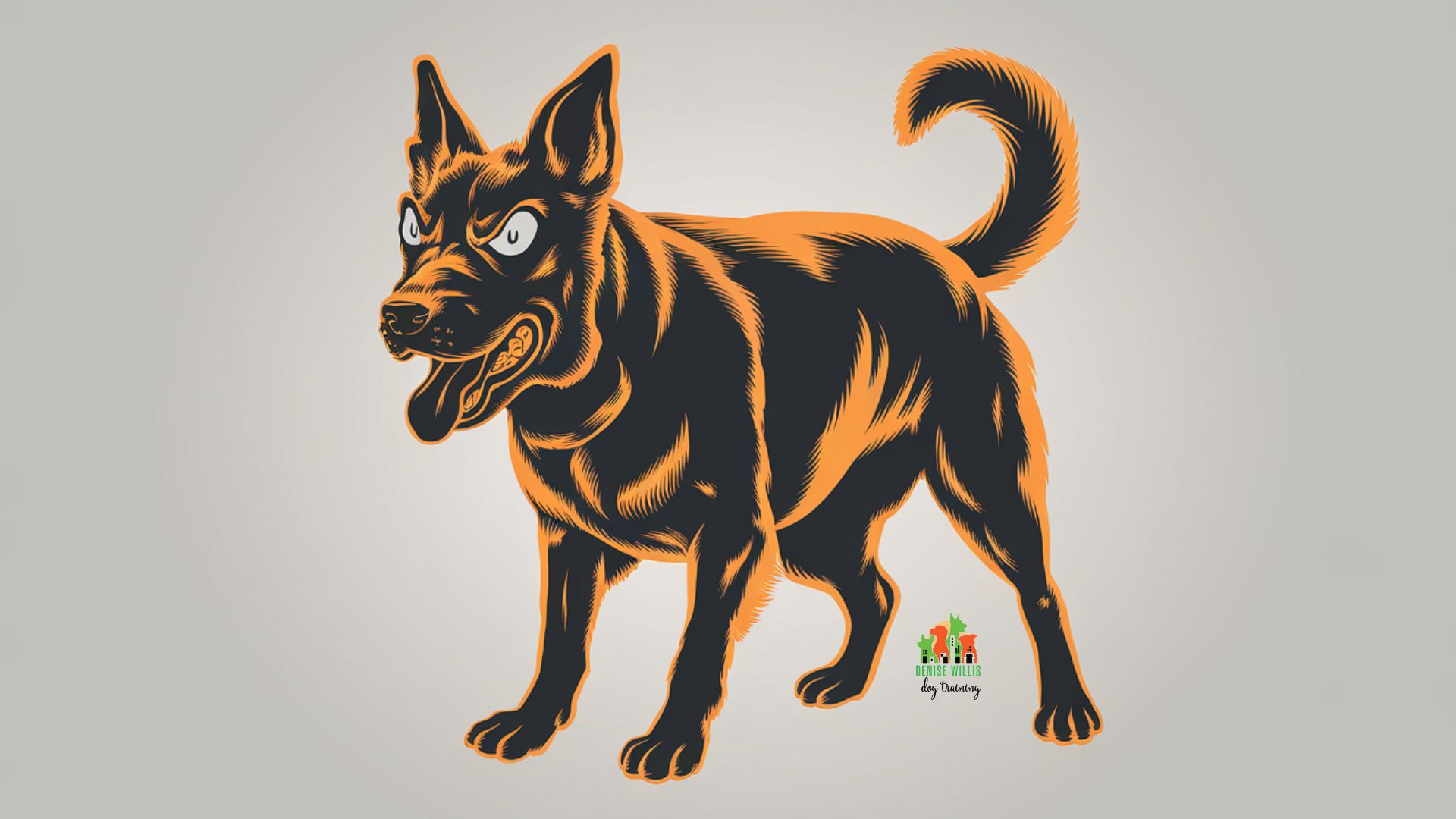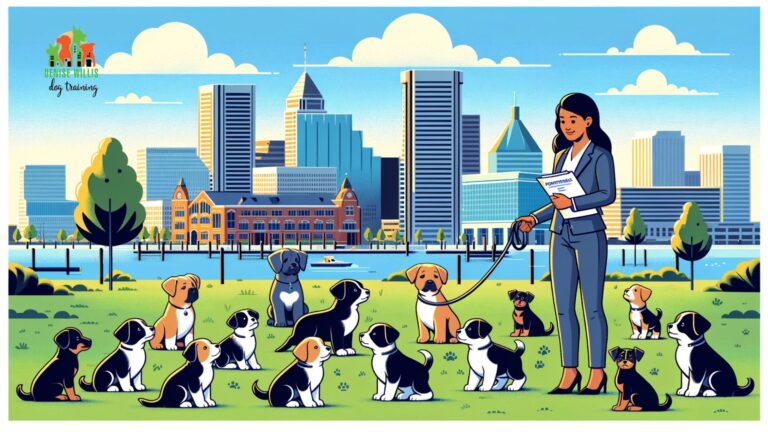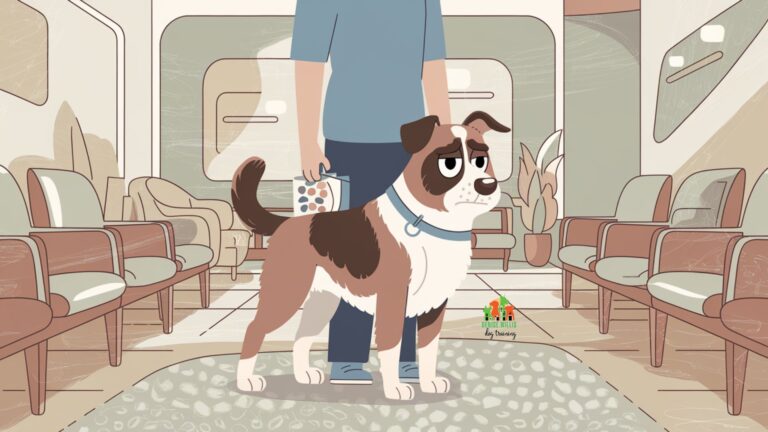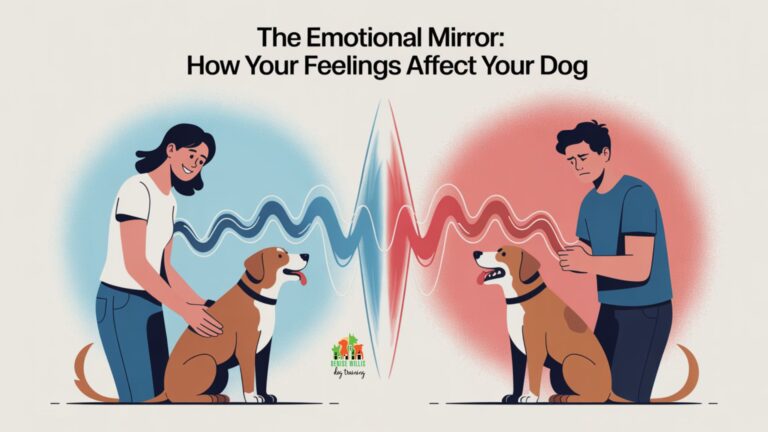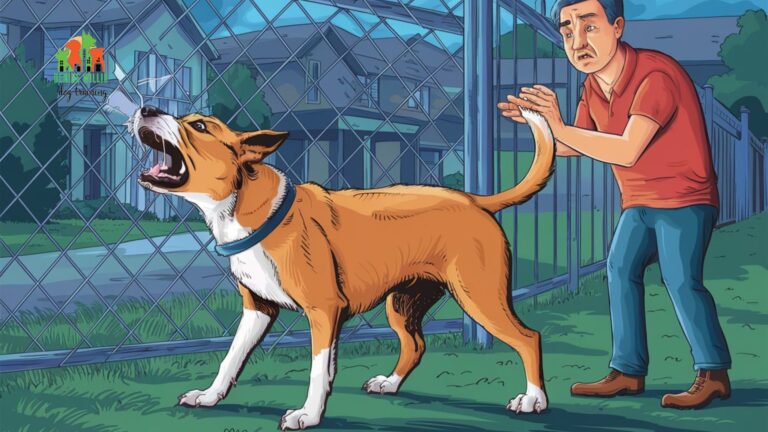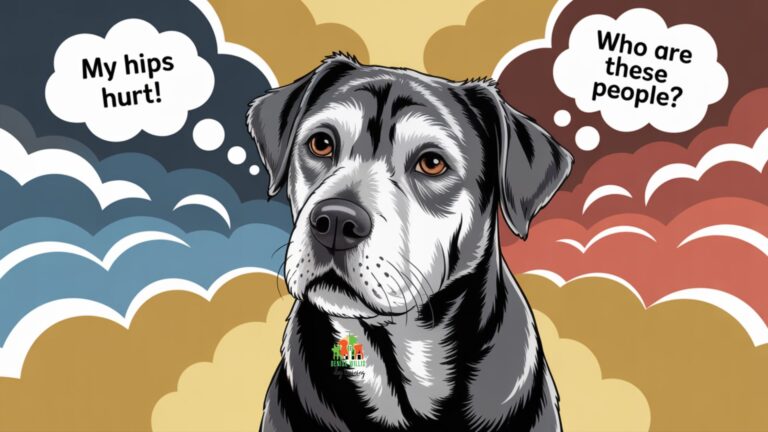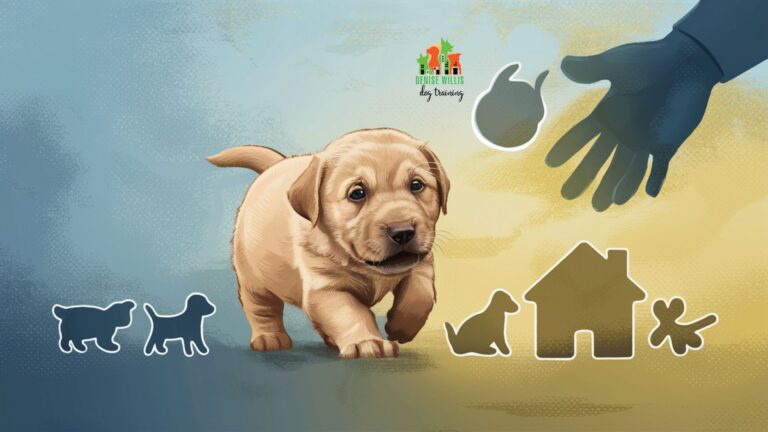Peaceful Public Outings: Controlling Dog Aggression Beyond Your Front Door
📍 Service Area Notice: DW Dog Training provides in-person training services exclusively in the Greater Baltimore area. While our blog content is designed to help dog owners internationally, our hands-on training services are locally focused. For readers outside our service area, we hope you find value in our articles and welcome you to reach out with questions!
That heart-stopping moment when your normally sweet pup transforms into a barking, lunging ball of fury at the sight of another dog across the street. We’ve all been there. As someone who’s spent over two decades helping dogs and their humans navigate these challenges, I can tell you that moment of panic isn’t just about your dog’s behavior. It’s about feeling helpless, embarrassed, and wondering if you’ll ever enjoy a peaceful walk again.
The good news?
You’re not alone, and more importantly, you’re not stuck. After training thousands of dogs, including my own reactive shepherd who once thought the mail carrier was plotting world domination, I’ve learned that understanding and managing dog aggression is less about quick fixes and more about seeing the bigger picture.
Key Takeaways
Before we dive into the nitty-gritty of transforming your reactive rover into a composed canine, let’s grab those training treats and highlight the essentials. Think of these as your “cheat codes” for the journey ahead:
- Most aggressive displays aren’t about dominance or being “bad” – they’re your dog’s way of saying “I’m uncomfortable!” in the only language they know
- A whopping 88% of problematic encounters involve off-leash dogs, proving that proper management is half the battle
- Your timing matters more than your treats – catching behavior before it escalates is like catching a glass before it shatters
- Those “unexpected” reactions? Not so unexpected when you learn to read your dog’s subtle body language cues
- Professional help isn’t admitting defeat – it’s like having a GPS when you’re learning to navigate a new city
Quick Pro Tip: Remember, your dog isn’t giving you a hard time; they’re having a hard time. Understanding this distinction changes everything about how you approach their training.
Now that we’ve got our training treats sorted (metaphorically speaking), let’s look at the real meat of managing dog aggression in public spaces. Just remember – even I once had a German Shepherd who thought the mailman was plotting world domination, and we turned that around.
The Big Picture: Four Pillars of Peaceful Pup Management
You know that moment when you’re trying to explain something complex and wish you had a nice, colorful diagram to point at? Well, grab your pointer stick (or that tennis ball your dog’s been eyeing), because we’re about to break down the essentials of managing dog aggression into bite-sized pieces. And yes, that pun was absolutely intended.
After spending time helping dogs go from “everyone’s a threat” to “maybe the mailman isn’t plotting world domination,” I’ve noticed patterns that consistently lead to success. Think of these four pillars as your dog training GPS – minus the frustrating “recalculating” announcements every time you make a wrong turn.
The Four Pillars of Managing Dog Aggression
Prevention First
88% of incidents involve off-leash dogs. Keep your dog leashed in public and learn to read early warning signs.
Understanding Fear
53.8% of aggressive behavior is defensive. Your dog isn’t being “bad” – they’re expressing fear or discomfort.
Training Tools
Proper equipment and positive reinforcement techniques create confidence and control for both you and your dog.
Owner Education
87% of people support owner accountability. Learn your dog’s triggers and manage them proactively.
There you have it. The foundation of successful aggression management laid out clearer than your dog’s “I need to go out RIGHT NOW” signals at 3 AM. Each of these elements works together like a well-orchestrated symphony, though sometimes it might feel more like herding cats (something your dog probably has strong opinions about).
Remember, just like your dog didn’t develop these behaviors overnight, mastering these pillars takes time. But unlike your attempt to teach your dog to load the dishwasher (still waiting for that breakthrough), these strategies actually work when applied consistently.
Understanding What’s Really Happening
Remember that time you walked into a party where you didn’t know anyone, and your anxiety level shot through the roof?
Dogs experience similar social pressure, but they can’t exactly grab a drink and make small talk to ease their nerves. According to research from Today’s Veterinary Practice, most aggressive displays in public aren’t about dominance or “being bad”. They’re about feeling overwhelmed and unsafe in a world that sometimes feels too big, too loud, and too unpredictable.
Here’s what’s fascinating.
Your dog’s aggressive display might look scary, but it’s often their way of saying, “I’m scared and I need space!” Think of it like someone who speaks very loudly when they’re nervous. The volume doesn’t match the emotion behind it. When my German Shepherd, Chewy, started showing signs of aggression toward other dogs, it wasn’t because he was mean-spirited. A deeper look revealed he was actually terrified of large dogs after a rough encounter at the park. Understanding this changed everything about how we approached his training.
The reality is that dog aggression in public spaces rarely develops overnight. Studies from VCA Hospitals show it’s usually a perfect storm of factors: genetics, early experiences, and yes, sometimes our own unintentional mixed signals.
Ever tensed up on the leash when you saw another dog coming?
Your pup probably noticed, and they might have interpreted your tension as confirmation that other dogs are indeed something to worry about.
The Science Behind the Bark
Let’s talk about what’s actually happening in your dog’s brain during these moments. You know that feeling when you’re stressed and someone tells you to “just calm down”?
Annoying, right?
Your dog feels the same way. When they’re in a state of high arousal, their body is flooded with stress hormones that make it literally impossible to think clearly or respond to commands they know well.
This is where most traditional training advice falls short. Trying to train a dog in the middle of an aggressive episode is like trying to teach someone calculus while they’re running from a bear. It’s just not going to stick. Research from Alpha Paws shows that successful aggression management starts way before the trigger appears, focusing on building new neural pathways when your dog is calm and receptive.
Here’s something that might surprise you.
Many dogs labeled as “aggressive” are actually struggling with undiagnosed physical issues. I’ll never forget working with a Rottweiler who had developed sudden aggression toward other dogs on walks. Multiple trainers had tried to help, but nothing seemed to work. It wasn’t until a thorough veterinary exam revealed early-stage hip dysplasia that the puzzle pieces fell into place. Once we addressed his pain management, his reactivity decreased significantly.
Creating Real Change
The path to peaceful walks isn’t about forcing your dog to ignore their instincts. It’s about teaching them new ways to handle stress. Think of it like upgrading your dog’s emotional software. The old program might say “Bark and lunge when nervous,” but with patience and the right approach, we can install a new one that offers better options.
DeMarine’s Dog Training research shows that the most successful rehabilitation programs focus on three key areas: management, modification, and maintenance. But here’s what they don’t always tell you. Progress isn’t linear. Some days your dog will be a star student, and others they might act like they’ve never seen another dog in their life. That’s normal, and it’s okay.
The trick is understanding that every reaction, every moment of stress, is actually an opportunity to learn something new about your dog. When my client Sarah’s Border Collie started showing aggression at the dog park, we discovered he wasn’t actually aggressive at all. He was trying to control a situation that made him uncomfortable. By giving him new jobs to focus on and building his confidence through controlled interactions, his need to control through aggression gradually diminished.
The Numbers Don’t Lie: A Reality Check on Dog Aggression
Remember that time you tried convincing your friend their “friendly” off-leash dog wasn’t actually making everyone’s day better? Well, grab your reading glasses, because the statistics are about to back you up with some serious truth bombs.
After my many years of doing this, I’ve seen patterns emerge that match what researchers are finding. It’s like that moment when scientists confirmed what grandmothers have known forever. Chicken soup actually does help with colds. Except in this case, we’re confirming what responsible dog owners have been saying all along: most aggressive incidents are completely preventable.
| Behavior Type | Percentage | Notes | Source |
|---|---|---|---|
| Off-Leash Incidents | 88% | Percentage of attacking dogs that were off-leash during incidents | [1] |
| Owner Presence | 82% | Cases where attacking dog’s owner was present during incident | [1] |
| Defensive Aggression | 53.8% | Percentage of aggressive incidents classified as defensive rather than offensive | [2] |
| Public Space Incidents | 37.9% | Percentage of aggression episodes occurring in public spaces | [6] |
| Owner Accountability | 87% | Public agreement that owners should be held legally accountable for dog attacks | [4] |
Well, those numbers certainly paint a picture, don’t they?
And not the kind you’d want to hang over your couch. Notice how 88% of incidents involve off-leash dogs? That’s not just a statistic. That’s a wake-up call wrapped in a math problem. Even more eye-opening is that 82% of owners were present during these incidents. Imagine being there to witness your dog’s questionable life choices and still thinking, “This is fine!”
But here’s the silver lining. that 53.8% defensive aggression statistic tells us something crucial: most “aggressive” dogs aren’t actually out there looking for trouble. They’re more like that introverted friend who gets overwhelmed at parties and starts frantically looking for the exits. Understanding this changes everything about how we approach the problem.
These numbers aren’t just data points. They’re stories waiting to be changed. And trust me, after helping hundreds of dogs transform from reactive rovers to calm companions, I can tell you that understanding these patterns is the first step toward writing a better story for your own dog.
The Tools That Actually Work
You know that saying about having the right tool for the job?
With dog aggression, it’s less about having a magic wand and more about building a reliable toolkit. After spending countless hours working with reactive dogs, I’ve learned that success often comes down to the simple things done consistently and with perfect timing.
Let me paint you a picture of what worked with my own reactive shepherd. The standard advice of “just avoid triggers” wasn’t cutting it unless I planned to walk him at 3 AM for the rest of his life. Instead, we developed what I like to call the “CIA approach”: Control, Intelligence (gathering), and Action.
According to research from Off Leash K9 Training, this systematic approach helps dogs build confidence while giving owners practical tools they can use in real-world situations.
Equipment That Makes a Difference
First things first. Let’s talk about gear. Not because fancy equipment magically fixes behavior issues, but because the right tools can give you the control you need to work on those issues safely. Think of it like learning to drive. You wouldn’t start in a Formula 1 car, but you also wouldn’t want a car with faulty brakes.
The most effective equipment setup I’ve found through years of training includes a properly fitted front-clip harness or martingale collar (depending on your dog’s build), combined with a sturdy 6-foot leash.
Skip the retractable leashes. They’re about as helpful in controlling a reactive dog as a wet paper towel is for mopping up a flood. Alpha Paws’ research confirms that consistent leash tension and control significantly impact a dog’s stress levels during reactive episodes.
Creating Your Management Strategy
Here’s where most people get stuck. They try to fix everything at once. Remember my client with the German Shepherd who thought every squirrel was plotting world domination?
We started with a simple rule: manage first, train second. This meant mapping out low-traffic routes, identifying “safe zones” for emergency retreats, and learning to read the environment like a four-star general planning a mission.
Your management strategy should be as unique as your dog. What works for my client’s overexcited Lab won’t necessarily work for your anxious Chihuahua. Today’s Veterinary Practice emphasizes the importance of tailoring management plans to individual dogs’ triggers and thresholds. Some dogs need a football field’s worth of space from their triggers, while others can handle passing at sidewalk distance as long as they’re moving.
Training Techniques That Transform
Let’s get real about training. It’s not about making your dog like every dog they see. It’s about teaching them they don’t need to throw a fit about it. Think of it like dealing with that one coworker who drives you nuts. You don’t have to become best friends, you just need to learn to share the break room peacefully.
The secret sauce?
Something I call the “Better Deal” approach. Imagine you’re offered $5 to do something annoying. Now imagine being offered $500 for the same task. Suddenly, it seems more worthwhile, right? According to Glad Dogs Nation, this concept of making alternative behaviors more rewarding than reacting is key to lasting behavior change.
The Power of Pattern Games
One of my favorite techniques involves using pattern games to help dogs focus in challenging situations. Picture a dog who normally loses their mind at the sight of another dog, calmly playing a targeting game instead.
Sounds impossible?
I thought so too until I saw it work with a particularly reactive Doberman who used to clear the local park faster than a fire drill.
The beauty of pattern games lies in their predictability. Dogs, like humans, feel more secure when they know what to expect. Research from VCA Hospitals shows that predictable routines can significantly reduce stress-related behaviors in dogs. We’re not just distracting them. We’re giving them a new, more rewarding behavior to replace the old reaction.
The Reality Check
Here’s something most trainers won’t tell you.
Setbacks are part of the process.
Last week, I worked with a Golden Retriever who had been doing amazingly well with his reactivity. Then, during what should have been a routine walk, he had a complete meltdown over a bicycle. His owner was devastated, feeling like all their progress had vanished.
But here’s the thing. Learning isn’t linear, for dogs or humans. Just like you might stress-eat an entire pizza after weeks of healthy eating, dogs have their moments too.
The key is recognizing that these setbacks aren’t failures.
They’re feedback.
Each reaction tells you something important about your dog’s current state, their triggers, and what they need from you. Sometimes, it’s as simple as realizing they’re overtired or that the pollen count has their anxiety levels higher than usual. Other times, it might signal that you need to adjust your training approach or consult with a professional for a fresh perspective.
Your Roadmap to Recovery: What to Expect
When you’re in the thick of managing dog aggression, it can feel like you’re stuck in an endless game of “dodge the trigger” with no finish line in sight. But just like training your pup to stop stealing socks (we’ve all been there), success comes with a plan and a timeline.
After helping countless dogs go from “everyone’s a threat” to “maybe the mailman isn’t so bad,” I’ve developed a pretty solid roadmap for what this journey looks like. Think of it as your GPS to better behavior – minus the annoying “recalculating” voice when things don’t go as planned.
Your Journey to Peaceful Walks: A Timeline
Day 1-7: The Reality Check
Time to face the music (and your dog’s trigger list). We’ll start with immediate safety measures like proper equipment and management strategies. Think of it as your dog’s personal security detail setup phase.
Week 2-4: Setting the Stage
No more accidental dog park drive-bys! We’re creating safe spaces, establishing routes that don’t feel like running a gauntlet, and getting comfortable with our new equipment. Your dog’s confidence starts here.
Month 1-3: Building the Foundation
Time to become the treat-dispensing ninja you were meant to be! We’re establishing basic commands and routines that will become your secret weapons for success.
Month 3-6: Leveling Up
Welcome to the behavior modification big leagues! We’re turning your reactive rover into a composed canine through systematic desensitization. Think of it as exposure therapy, but with more treats.
Month 6-12: Social Butterfly Training
Time for some carefully planned playdates! We’re introducing controlled interactions and parallel walks, showing your dog that other pups aren’t actually alien invaders.
Year 1-2: Fine-Tuning
Now we’re cooking with gas! Regular progress checks, increasing challenges, and adjusting strategies as needed. Your dog’s like a graduate student of good behavior now.
Long-term: Living Your Best Life
Maintenance mode! Keep those skills sharp, stay alert for new challenges, and enjoy those peaceful walks you’ve worked so hard for. You’re not just walking your dog anymore – you’re walking with your partner in crime (the legal kind).
Remember, this timeline isn’t set in stone. It’s more like a well-informed suggestion based on years of experience and countless success stories. Some dogs might zip through certain stages like they’re chasing squirrels, while others take their sweet time, stopping to sniff every metaphorical tree along the way. And that’s perfectly okay!
The key isn’t how fast you move through these stages, but how solidly you build each foundation. After all, you wouldn’t try to teach your dog advanced agility before they’ve mastered “sit,” right? (Though wouldn’t that be entertaining to watch?)
Product Recommendations
Shopping for a reactive dog is like preparing for a secret agent mission except your operative has four paws and thinks squirrels are public enemy number one. Let’s gear up with some tools that would make even James Bond’s “Q” Branch jealous!
- PetSafe Gentle Leader Headcollar: Turn your canine superhero into a sophisticated diplomat with this game-changing headcollar. It’s like power steering for your dog, giving you smooth control without the drama. Perfect for those “squirrel!” moments when your pup suddenly thinks they’re in an action movie. Warning: Your dog may temporarily believe they’ve joined an exclusive club where everyone wears fancy face accessories.
- ThunderShirt Sport Dog Anxiety Jacket: Like a warm hug in clothing form, this anxiety jacket helps your fearless protector remember they don’t actually need to save the world. The snug fit provides calming pressure that works like magic – or science, but magic sounds cooler. Warning: May cause excessive snuggling and temporary belief that they’re wearing invisible armor.
- JULIUS-K9 PowerHarness: The Ferrari of dog harnesses, this bad boy combines style with incredible control. It’s like giving your dog a superhero costume that actually helps them behave better. The reflective strips mean your night patrol champion can still be seen after dark. Warning: Your dog may start posing for photos like they’re about to drop the hottest album of 2025.
- Zuke’s Mini Naturals Training Treats: These tiny treats are like doggy Bitcoin – small, valuable, and your pup will work hard to earn them. Perfect for rewarding those moments when your dog chooses to be a gentleman instead of a bouncer. Warning: Your dog may start performing random good behaviors in hopes of hitting the treat jackpot.
- Kong Extreme Dog Toy: The Fort Knox of dog toys, perfect for redirecting your pup’s protective instincts into something productive. Stuff it with treats and watch your security officer transform into a puzzle-solving genius. Warning: Your dog may start expecting all their meals to come from black rubber cones.
While these gadgets won’t turn your protective pooch into a zen master overnight, they’ll certainly make the journey more entertaining. And, if all else fails, at least your dog will look incredibly stylish while learning to be less of a drama queen!
Further Reading
Think you’ve mastered the art of handling your reactive rover? Hold onto your leash, because we’re about to take a deeper dive into the fascinating world of canine behavior. Warning: Side effects may include spontaneous “aha!” moments and an irresistible urge to analyze every dog you meet.
- Environmental Triggers for Dog Aggression: Discover why your dog thinks the neighbor’s garden gnome is plotting world domination. A fascinating look at how environment shapes behavior, minus the conspiracy theories.
- The Shocking Truth About Dog Aggression After Neutering: Everything you need to know about how the snip-snip affects your dog’s zip-zip. Spoiler alert: It’s more complicated than your dog’s relationship with the vacuum cleaner.
- Stress-Induced Dog Aggression: Learn why your pup isn’t just being dramatic. They’re actually experiencing the canine version of a bad hair day, every day. Contains fewer yoga recommendations than you’d expect.
- 10 Warning Signs Your Dog Might Bite and How to Prevent It: Because “their tail was wagging” isn’t always the green light you think it is. Decode your dog’s secret language before they write you a strongly worded letter.
- Decoding Your Dog: 15 Body Language Signals You Need to Know: Finally, a translation guide for all those weird things your dog does! Turns out they weren’t just practicing their yoga poses after all.
Ready to become a certified dog behavior detective?
These articles are your training treats for the mind. Devour them wisely!
Just remember, while reading won’t instantly make you the next Dog Whisperer, it’ll definitely make you the most interesting conversation starter at the dog park. Just don’t forget the real treats. Your dog isn’t impressed by your newfound knowledge alone!
Frequently Asked Questions About Managing Dog Aggression
Q: How long will it take to see improvement in my dog’s reactive behavior?
A: While every dog moves at their own pace, most owners start seeing small changes within 2-4 weeks of consistent training. Those moments when your pup looks at you instead of barking at a trigger? That’s progress! Major improvements typically show up after 3-6 months of dedicated work.
Q: Can my reactive dog ever safely play with other dogs?
A: Many reactive dogs can learn to interact safely with other dogs, but it requires careful assessment and gradual introduction. According to Alpha Paws, success often depends on understanding your dog’s specific triggers and working with a professional to create positive associations.
Q: Should I muzzle my dog during training?
A: Muzzle training can be a valuable safety tool when properly introduced. Think of it like wearing a seatbelt – it’s not about expecting something bad to happen, it’s about being prepared. USA Dog Behavior recommends introducing muzzles gradually and making them a positive experience.
Q: What if my dog seems fine at home but reactive in public?
A: This common situation often relates to threshold levels. Your home is predictable and safe, while public spaces present multiple challenging variables. Professional guidance can help you bridge this gap effectively.
Time to Test Your Dog Detective Skills!
You know that feeling when you think you’ve got something figured out, and then your dog throws you a curveball? (Like that time my German Shepherd decided the garden hose was suddenly a snake-monster hybrid?) Well, before we dive deeper into solutions, let’s make sure you’re picking up what I’m putting down about dog aggression management.
Don’t worry.
This isn’t like those pop quizzes from high school that still haunt your dreams. Think of it more like a friendly game of “Who Wants to Be a Millionaire?” except instead of phone-a-friend, you can use everything we’ve just covered. And while you won’t win any cash, you might just win more peaceful walks with your pup!
Test Your Knowledge: Managing Dog Aggression
How'd you do?
Whether you aced it or learned something new, remember that understanding dog aggression is more marathon than sprint. Even after two decades of training, I still have those "aha!" moments when a dog shows me something new. The key is taking this knowledge and putting it into action.
Final Thoughts
Remember that day you first realized your dog's reactivity was more than just "bad behavior"? That moment of understanding marks the beginning of real change. Through this guide, we've explored the science behind aggression, practical management strategies, and the power of consistent, positive training approaches.
Your reactive dog isn't giving you a hard time.
They're having a hard time.
With patience, understanding, and the right support system, those peaceful walks you've been dreaming about are absolutely achievable. I've seen countless success stories in my decades of training, from the Rottweiler who learned to love his former triggers to the anxious Shepherd who became a neighborhood role model.
At DW Dog Training, we specialize in turning these challenges into triumph stories. Our proven methods combine cutting-edge behavioral science with practical, real-world solutions tailored to your dog's unique needs. Whether you're just starting your reactive dog journey or feeling stuck in your progress, we're here to help you and your pup find your path to confidence and calm.
Ready to transform those stressful walks into enjoyable adventures?
Contact DW Dog Training for a personalized evaluation. Let's work together to help your dog become the best version of themselves - one peaceful walk at a time.
Share Your Story
Has this article helped you understand your dog's behavior better?
We'd love to hear about your experiences and journey with your reactive dog. Your story could inspire others facing similar challenges and help build our supportive community of dog owners. Drop a comment below or reach out to us directly to share your thoughts, questions, or success stories.
Remember, every reactive dog journey is unique, and your experiences matter. By sharing our stories and supporting each other, we create a stronger, more understanding community for all our four-legged friends.

